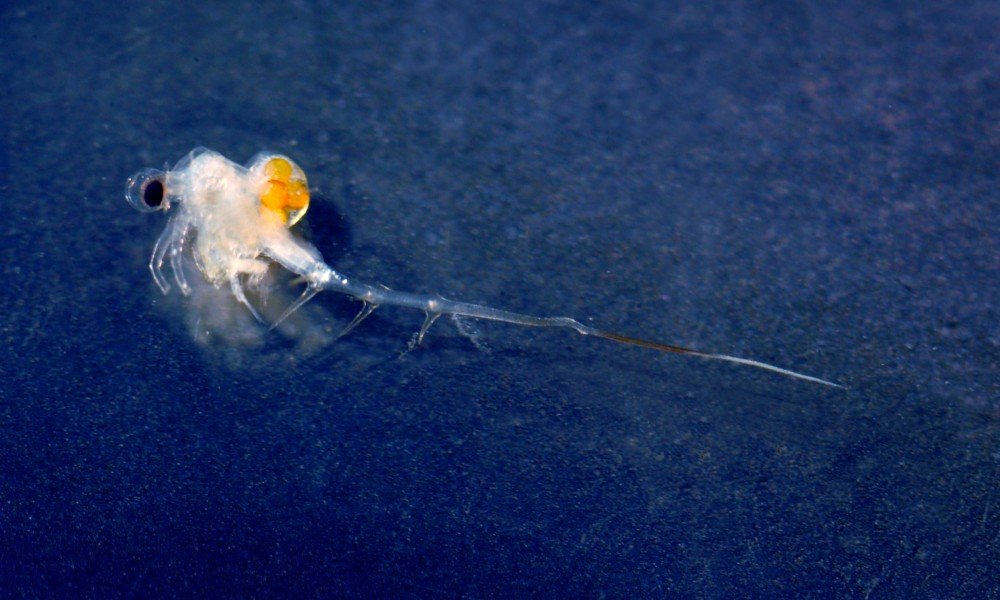Spiny Water Flea (Bythotrephes longimanus)
Description
The spiny water flea (SWF) is a free swimming, cladoceran zooplankton with a unique body structure. Its average length is only about one centimeter, but its long tail spine (70% of animal's total length) makes it easily distinguishable from other invertebrates and zooplankton. The spine has one to four pairs are thorn-like barbs. The barbs can be used to determine the age of the crustacean for offspring are born with one pair and gain more barbs throughout life.
This large predatory zooplankton is a generalist feeder and commonly preys upon small bodied, slow cladocerans. It has a large, black compound eye, and therefore vision is thought to play a role in B. longimanus's prey detection and encounter. SWF's predation rates and success positively correlate with the increase in light intensity specifically with Daphnia mendotae (an herbivorous, cladoceran zooplankton). Most rapacity and highest densities of SWF occur in the first ten meters of the epilimnion which further supports vision mediated predation. These findings suggest that water clarity and turbidity play an important role in the establishment of SWF as well as supports its distribution in clear, oligotrophic lakes.
The spiny water flea's life cycle has rapid and unique reproductive strategies. Like other water fleas, Bythotrephes partakes in seasonal parthenogenesis. During late spring individuals emerge from resting eggs in lake sediments. When temperatures are warm enough and food is abundant, B. longimanus will exhibit parthenogenesis. This assexually mode of reproduction allows female spiny water fleas to produce one to ten eggs independent of fertilization that successfully develop into genetic replicas of the mother. At optimum temperatures parthenogenesis produces a new generation of females in less than two weeks. Female clones are propagated throughout the summer or until temperature and food availability is unfavorable for SWF.
Native Range and Distribution
SWF is native to the Palearctic (Eurasia) region. Like most aquatic invaders from Eurasia, the SWF has been transported to North America's Great Lakes via ballast water from Baltic ports. B. longimanus has been observed in Lake Ontario since 1982 and soon after in Lakes Huron and Erie. Since 2008 it has been established in the Great Sacandaga Lake in New York and has been discovered in other Adirondack water bodies including Peck Lake, Stewarts Bridge Reservoir, and Sacandaga Lake. In 2012, the spiny water flea's presence has was confirmed further north in the Adirondack Park at Lake George. There is a growing consensus that humans are the primary transporters of spiny water flea, and it is important to understand its role and effects on the aquatic ecosystem.
Threats and Impacts
The spiny water flea's dense populations from constant reproduction and generalistic predation of zooplankton during the summer result in changes of zooplankton species richness and composition following the establishment of this invader. A study that examined zooplankton species richness from May-September in Canada has found significantly reduced cladoceran (SWF main prey) species richness, diversity, and abundance as well as a loss in total zooplankton community richness, diversity, and abundance. SWF effects on aquatic ecology are hard to distinguish, but they certainly alter native zooplankton community distribution and structure within the water column.
The loss of native zooplankton due to heavy predation by SWF negativley affects native fish populations. B. longimanus can deplete important food resources for juvenile fish, increasing competition and reducing survival rates. Although the spiny water flea can be preyed upon by fish, thier large spines make it difficult for most fish to swallow them. In addition, the SWF creates a nuisance to fisherman by clogging rod eyelets and accumulating in large masses on fishing lines and downrigger cables.
Management
There is NO KNOWN MANGEMENT for spiny water flea. Prevention is the only means to reduce the spread of this aquatic invasive species. Always remember to clean, drain, and dry your boat, trailer and all equipment that contacts the water.
Additional Information on Spiny Water Flea
Spiny Water Flea and Fishhook Water Flea by Michigan Sea Grant
Spiny Water Flea Fact Sheet by National Park Service
Spiny Water Flea Fact Sheet by Iowa Department of Natural Resources
Spiny Water Flea Literature Review by Adirondack Watershed Institute

